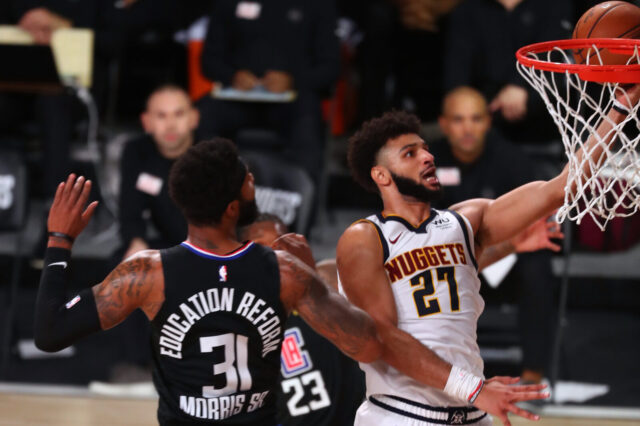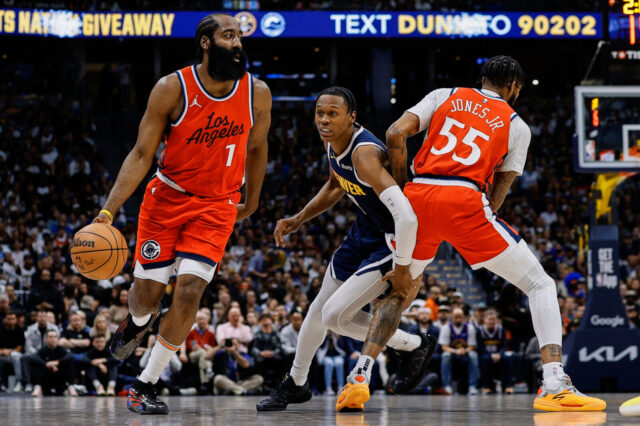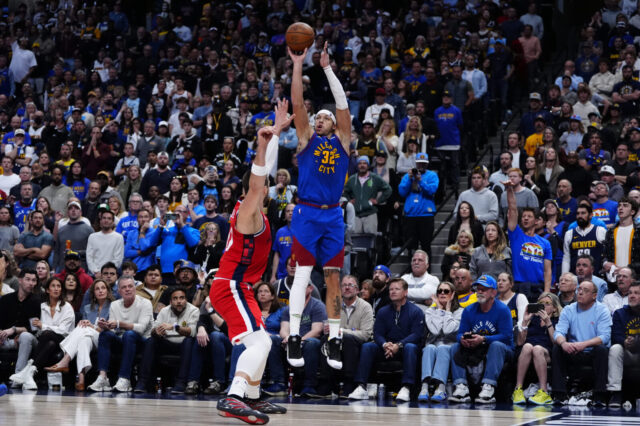The Denver Nuggets are in the thick of one of the tougher parts of their schedule but also one of the more difficult stretches of the NBA schedule as well. With 33 games under their belt and 49 to go, physical fatigue is present but mental fatigue most of all. The holiday season is coming to an end and the Nuggets will play 25 more games until they hit the All-Star break. The beginning of the season garnered excitement for all and that has worn off especially for the Nuggets.
Through their first 15 games, late October to mid-November, the Nuggets held a 9-6 record. They went 4-2 in October while scoring the 4th least PPG at 101.3. Through that nine-game stretch in November, they only averaged 104.4 PPG yet they had a winning record at 5-4. With that being said, the only reason the Nuggets were winning games was because of their defense. Through their first 15 games, they held opponents to 99.2 PPG.
Their consistency at home was a key factor in their success. In their first eight home games, they went 7-1 and held every opponent under 100 points. Since November 14th, they are yet to hold a team to under 100 at home. The mile-high is one of the best home-court advantages in all of basketball, and the Nuggets are not capitalizing of late. They have only played six home games dating back to November 18th, but they are an astounding 1-5 in those games. Denver is yielding about 114 PPG in that span while only scoring 105.5 PPG themselves.
The point is, the Nuggets lack identity right now. They don’t do anything exceptional right now as they are middle of the pack in most statistical categories, they aren’t protecting home court, they struggle on the road, so what are they? Currently, their identity appears to be founded on what they don’t do well. They shoot better on the road but can't defend a lick. They defend better at home but their offense continues to struggle. This is a very confusing bunch right now, but what can we do to bring back hope in the mile-high city? We make some New Year’s resolutions.
Home cookin’
My number one New Year’s resolution for this team is to excel at home. Right now, Denver isn’t cooking up anything at home other than Grandma’s overcooked Brussel sprouts. The Nuggets have not played a lot of home games yet this year so this is a very achievable resolution here. In their last three years, the Nuggets have won over 69% of their home games. This year, they are 8-6 with a significant amount of home games to play. As I stated before, the Nuggets don’t stand out in any particular category so this could and should be where they play great basketball.
Although their defense needs to improve, they really need to find their offensive rhythm at home. At the moment, they stand 26th in the league in home scoring at 104.7 PPG. Their FG% is 20th at 45%, their 3P% is 23rd at 33%, and they are 28th in free throw attempts at 18 a game. As the stats suggest, they are not as comfortable shooting at home as they are on the road which is a problem. Through further analysis, another glaring issue reveals itself. Second-half scoring. They rank 26th in second-half scoring at home with 50.5 PPG.
In the first half, they score about 54 PPG, shoot 46.2% from the field, grab 24 rebounds per game (2nd in the league), compile 14 assists per game (6th), and only turn it over about 6 times a game (6th).
What’s shocking is not that these numbers decrease in the second half but in the landslide fashion in which they do so. They score about four points less and shoot 3 percentage points less from the field in the second half, which is not completely awful but the other aspects are. They are 2nd in the league in rebounds in the first half, but that number decreases all the way to 24th in the second half. Their ranking in assists goes from 6th down to 21st, and their turnovers also dip from 6th down to 24th. Oh and I almost forgot, they are 3rd worst in 4th quarter scoring at 24 PPG.
I am not a part of the team nor in the locker room every day, so I can’t accurately depict what their mentality becomes in the second half, but every loyal Nuggets fan can see what’s going on. Sure, there might be spurts of energy here and there but it is not consistent throughout the majority of the half. When they have a lead, they seem to be complacent with missing several perimeter shots without touching the paint and when they trail, they appear to pressure themselves even more by focusing on the three-point line. You would be surprised to know the Nuggets actually hold opponents to just 52 PPG in the second half, whether that be at home or on the road. That is the 7th best mark in the league but they rarely can produce effective offense and defense at the same time.
Overall, I would like to see the Nuggets grow an identity at home. There are many extraneous factors they can capitalize on, whether that be the altitude, fans, or simply the notion of comfortability on home court. At any location but especially at home, take the fundamentals of the game and master them. Rebound with ferocity, defend with controlled aggression, and move the ball with confidence.
Physicality
Number two on my list is physicality. I don’t like to use the word soft in athletics but the Nuggets have had that reputation and it is illuminating itself once again. Individually, I don’t think Denver rosters any “soft” players, but collectively they are offering the opponent whatever they desire in many clutch moments. In this season’s infamous Timberwolves game where they set a franchise record for threes, where was any type of obstruction to their plan? Sure, players make contested shots but most of their looks seemed very comfortable. Some may think physicality only happens in the paint but it is essential to have on the perimeter as well.
Sometimes, I relate defending a three-point shooter to what a pitcher does in baseball. As a pitcher, you cannot let the batter get comfortable at the plate or he will have supreme confidence. That is why many pitchers will what we like to call, “brush a batter off the plate.” That means throwing a fastball inside and nearly hitting the batter. Sure, it may sound aggressive but when you do that, it creates uncomfortable thoughts in the batter’s head. Is he going to do it again? What pitch is he going to throw now and where? If you get the batter guessing, you are operating at a major advantage.
Similarly, if you get a shooter guessing, that player is not as comfortable. Thoughts may include: Am I going to be free off this screen? Will he swipe the ball as I rise for the jumper? Should I take it to the paint because he is crowding me so much? None of these thoughts are in Anthony Edward’s head as you will see in this clip.
Whenever you see an All-Star caliber player like Edwards retreat between his legs like he did, it’s almost a simile for “I’m about to expose you.” Of course, it’s difficult for Green to crowd his space as an older player, but you have to take away something. To that point, Edwards had 24 points and already knocked down several threes midway through the 3rd quarter. Even if you look at Green’s contest, he shows a hand for about a millisecond. If you pause the clip at the 5-second mark, Edwards's vision is not impeded at all. Where were the adjustments?
Although the rules of 90’s basketball have basically been abolished, there is still room for some of that mentality. For example, the “Jordan Rules.” The Bad Boy Pistons knew if they let Jordan get comfortable in the lane it was an automatic bucket. So when they saw him driving, they gave him the good ol’ love tap and sent him to the floor. Sure, it’s a foul but that player might hesitate or think twice before coming into the lane again. By no means am I encouraging any type of violence such as the Jokic shove on Markieff Morris, but taking a hard yet controlled foul will prevent the opposition from maintaining a comfy possession.
Although this next clip doesn’t show much physicality this is how you can prevent comfortable looks from three-point shooters:
Davis Bertans has been a Nugget killer and he was once again in this game, but Denver defended well on this possession. This is what good defensive intensity looks like. The defenders are scrambling all over the floor, forcing Washington to speed up and make quick decisions. Once Beal kicks it to Bertans, Green doesn’t hesitate and he sprints to the three-point line to run him off. This is what you want to do with Bertans because his role is essentially just being a spot-up shooter. He then drives to the lane, kicks it out, and the help defense recovers and forces the guard to give it up. What’s next is the most important part. Bertans then runs back to the three-point line for the attempt and airballs. Why? Since the Nuggets ran him off the perimeter the first time, he had been sprinting all over the floor, so he didn’t have the same energy as he had for the first attempt. He is also off-balance, in part, because he spent so much energy with his legs cutting and sprinting throughout the possession, thus the airball because his legs were tired.
With all that being said, the Nuggets are 17-16 with the 5th spot in the Western Conference. Denver will transform and adapt their play as the season progresses, but if they want a practical shot at a deep playoff run, it starts with intense, controlled play and being a team others fear at home.


